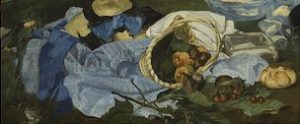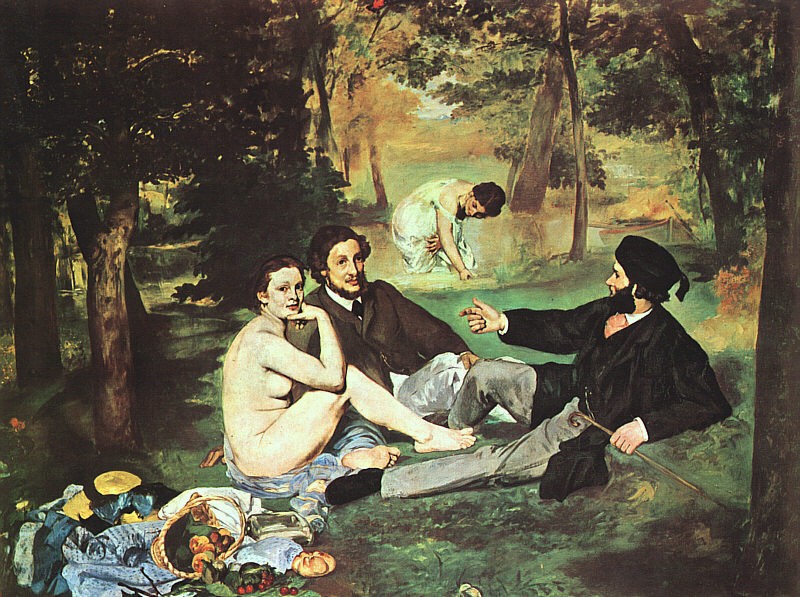Manet’s Le déjeuner sur l’herbe is a French euphemism for picnic in English. Pique-nique was not used for an alfresco luncheon but for dinner indoors, repas de pique-nique.
When it was exhibited in 1863 at the Salon des Refusés, the painting was titled Le bain, The Bath. But no one was fooled by its sexual connotations. Some claim Manet privately referred to the painting as that partie carrée, a sexual tryst, but I’ve yet to find a direct quote. When the painting was unsold in 1867, he retitled it Le déjeuner sur l’herbe, or even un partie de campagne.
If Manet had titled the painting a partie carrée, his intentions might have been more clearly understood. Critics and jaded upper-class Parisians were baffled. If this is an outing for bathing, why are the men clothed? Why is the only bather deep in the background? And why is the nude woman, prominently in the foreground, so obviously striking a sensual attitude and glaring at the viewer? Manet’s wit was impenetrable, and he offered no guidance. (
When Manet’s friend Emile Zola defended the painting, it was still Le bain. In a series of essays praising Manet’s style and painterly technique, “A New Manner in Painting: Édouard Manet,” Zola accused the Parisians of being “scandalized” at seeing a nude woman enjoying lunch outdoors. He asked, “What could be simpler than two couples enjoying the outdoors?” he disingenuously asked. Zola indignantly claimed otherwise, though he knew better because he was composing a picnic partie carrée for Madeleine Férat (1868), which he dedicated to Manet.
Manet’s selection of picnic foods is symbolically sexual. The basket is overturned, suggesting loss of innocence—though for who is uncertain if that matters. These foods, however, plainly reinforce sexual associations: oysters are regarded as aphrodisiacs; cherries and peaches have suggestive contours that resemble the female torso. A chaffinch hovering over the seated trio may suggest lechery. But it’s obscured in the tree foliage and must be pointed out to be seen.
Manet’s selection of picnic foods is symbolically sexual. The basket is overturned, suggesting loss of innocence—though for who is uncertain if that matters. These foods, however, plainly reinforce sexual associations: oysters are aphrodisiacs; cherries and peaches suggest the contours of the female torso. A chaffinch, obscured in the tree foliage, hovering over the seated trio suggests lechery.

Featured Image: Le déjeuner sur l’herbe (1863), oil on canvas. Musée D’Orsay, Paris.
See Beth Archer Brombert. Édouard Manet: Rebel in a Frock Coat. Boston: Little Brown and Company, 1996; Robert Lethbridge, editor, and translator, Looking at Manet: Writings on Manet by Emile Zola. London: Pallas Athena, 2013; Paul Hayes Tucker. Ed. Manet’s Le dejeuner Sur L’herbe. New York: Cambridge University Press, 1998; Ronnie Butler. “Zola’s Art Criticism (1865-1868), “Modern Language Studies 10, no. 4 (1974); Jean-Max Guies and Alison Hilton, ed. Emile Zola and the Arts. Washington, D.C.: Georgetown University Press, 1988.
Le déjeuner sur l’herbe,is often imitated, adapted, and (infinitely) satirized in all mediums and genres. In the arts, see Claude Monet’s unfinished Le Déjeuner Sur L’herbe (1865); Pablo Picasso’s variations on Manet’s theme, especially the monumental sculpture fabricated by Cark Nesjar (1964-1966); and Vladimir Dubosarky and Alexander Vinogradov’s The Luncheon on the Grass (2002). For fiction, see Emile Zola’s Madeleine Férat: A Realistic Novel (1868); Jane Bowles’s story “A Day in the Open” (1945c.); John Fowles’s novella The Ebony Tower (1974) and Martin Amis’s novel Dead Babies (1975).
\

